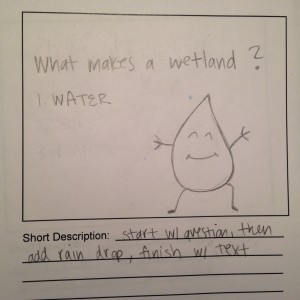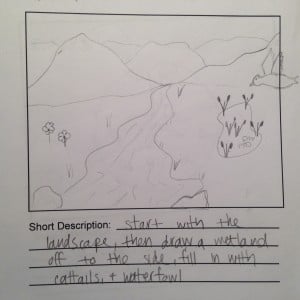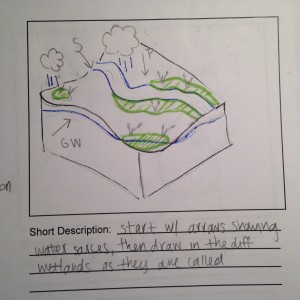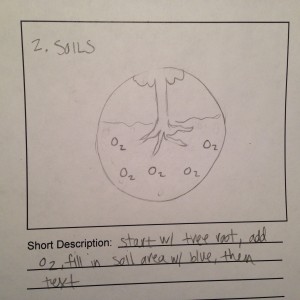What Makes a Wetland a Wetland?
Project Update: During some informal conversations with friends and family, I realized there is much less understanding of what a wetland is than I had originally thought. So I decided I would like to focus my project primarily on what exactly makes something a wetland (i.e., hydrology, soils, and plants). I have copied the first draft of my script below, and some draft sketches for the animation. I still need to work out a few kinks, and transitions between topics, but this draft covers the basic framework of what I would like my audience to learn.
I am still struggling with how to end the animation. First of all, it is entirely possible that this script is too long for a 2-3 minute video. Aside from that, I can’t decide what theme to end on. I think it is really important to reinforce why wetlands are important – so that’s how I currently end my script. But I also really want to convey how changing climate affects wetland hydrology (not yet in the script). I don’t think I have enough time to cover both ecosystem functions and wetland vulnerability, so if I had to choose one, which should it be?
Script 1.0
- What makes a wetland a wetland? Well the simplest answer is water.
- Wetlands are not completely dry, nor are they bodies of water such as a lake, pond, river, or stream. Wetlands are areas of land either permanently, or periodically saturated with water.
- Sources of water to wetlands include precipitation, runoff, groundwater, and tides.
- While many wetlands are found in transitional zones between upland and aquatic ecosystems, for example next to a river or lake,
- Wetlands can also form anywhere on the landscape with an accumulation of water such as surface depressions that collect rainfall and runoff, or areas where groundwater discharges to the land surface
- The development of characteristic wetland soils, and the growth of specially adapted wetland plants depends on the presence of water.
- In most non-wetland soils, oxygen is readily available to plant roots and oil bacteria. However, in saturated soils water displaces oxygen, leading to anaerobic, or oxygen-limited conditions. These are called hydric soils
- In fact, decomposition in anaerobic soils is what gives wetlands their characteristic rotten egg smell.
- Plant species have varying tolerance of saturated soils.
- Species such as cattails are almost always found in wetlands, while other species such as red maple are equally likely in wetland and upland habitats
- Wetland plants, also known as hydrophytes, have evolved special adaptations that allow them to survive and grow in low-oxygen hydric soils.
- Wetland water levels, or hydrology, can range from permanently to rarely flooded. Some wetlands may have a shallow layer of standing water, while others may be muddy, or even appear dry for much of the year. However, as long as saturated conditions persist long enough to develop hydric soils and support wetland plants, the area is considered a wetland.
- There are many different types of wetlands depending on the hydrology – movement of water, soils, and plant species found there.
- For example, marshes are permanently or temporarily flooded wetlands, often dominated emergency vegetations such as cattails or marsh cordgrass.
- While swamps are forested areas dominated by woody vegetation such as bald cypress and tupelo trees, and subject to seasonal patterns of inundation.
- Although once viewed as stinky, insect-ridden wastelands, we now know that wetlands perform many important ecosystem functions.
- Wetlands act as a natural filter to improve water quality. Often described as nature’s kidney’s, wetlands remove excess nutrients, sediment, and pollutants from our waterways, just like kidney’s filter toxins from our blood
- Wetlands also provide protection from floods and storm surge, and plants provide food, habitat, refuge, and nursery grounds for many fish, birds, invertebrates and small mammals.
Animation Image Ideas:
First Image – Happy Raindrop
Wetlands are not completely dry, nor are they bodies of water . . .
Wetland Water Sources
Hydric Soils




